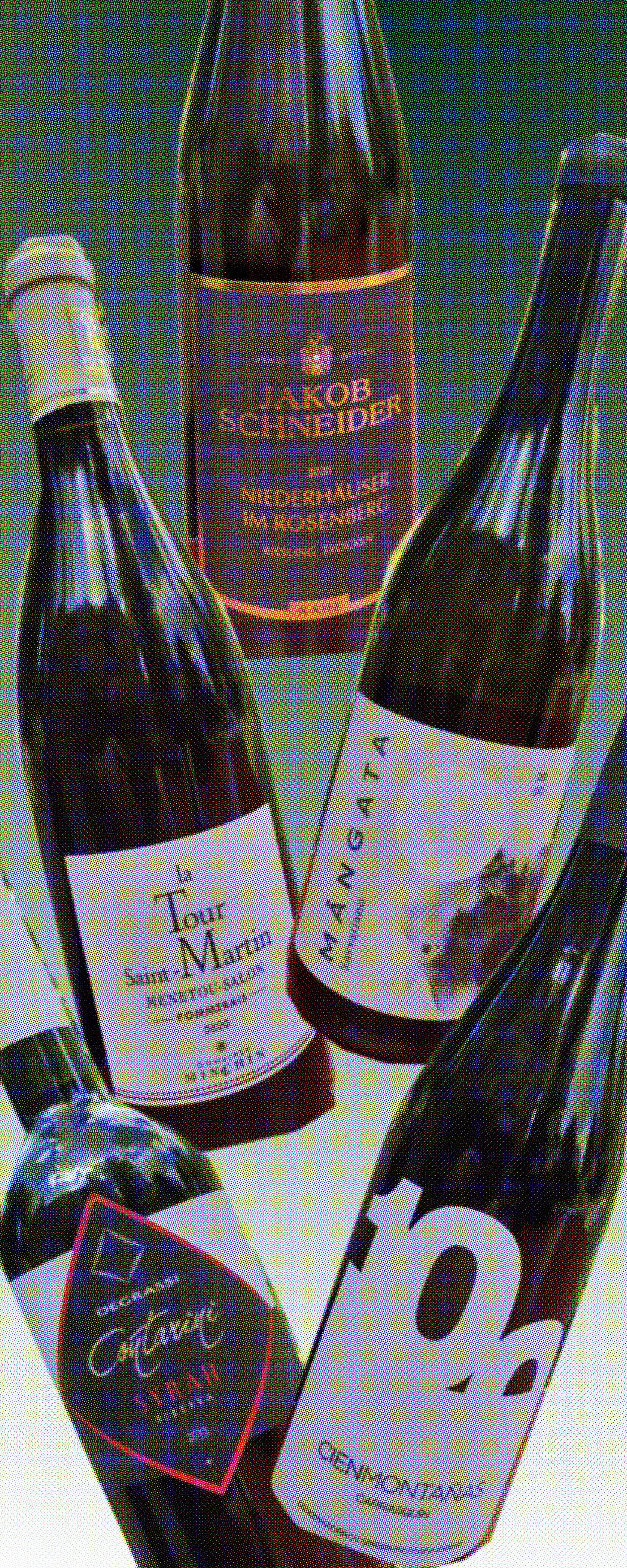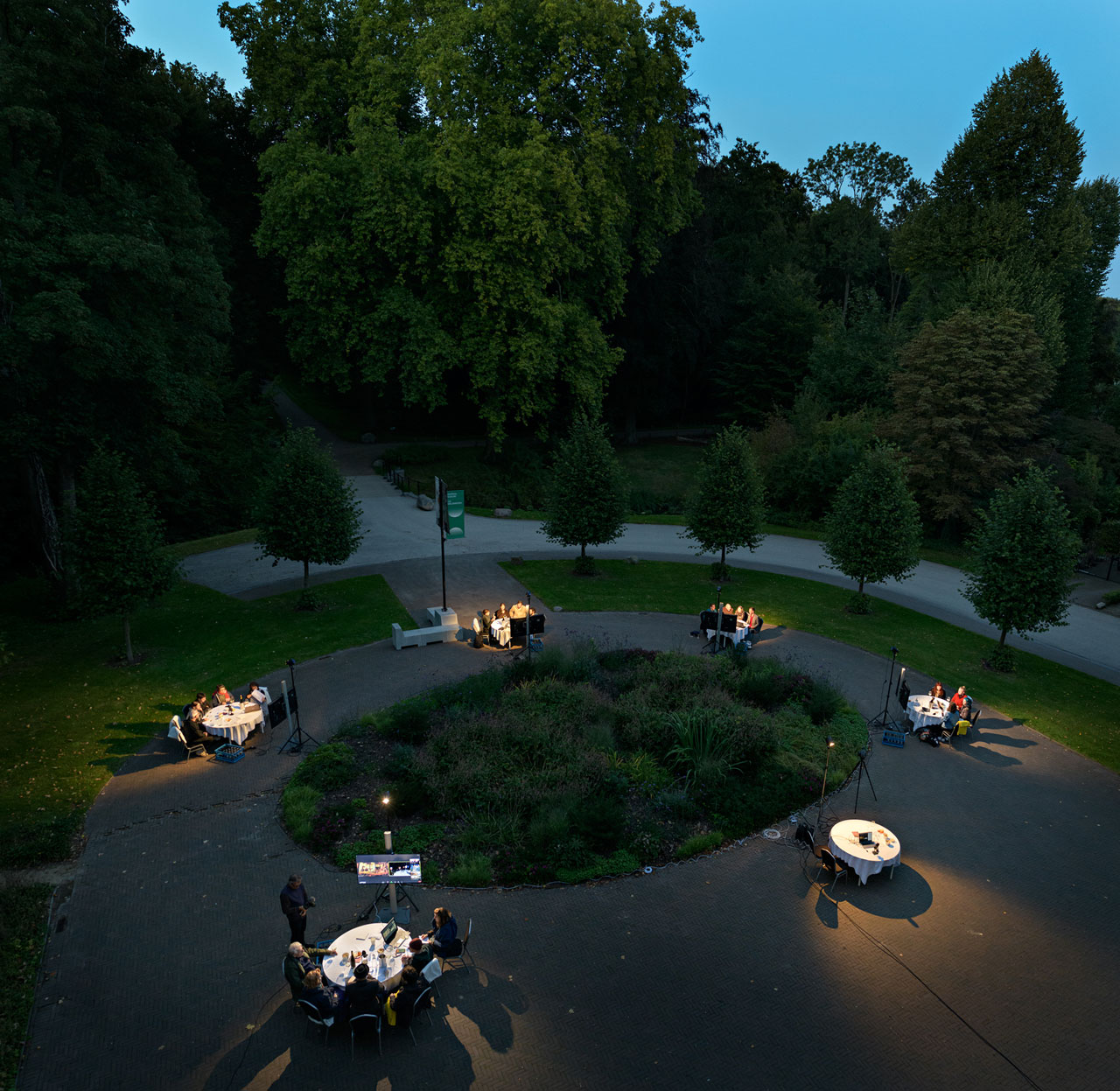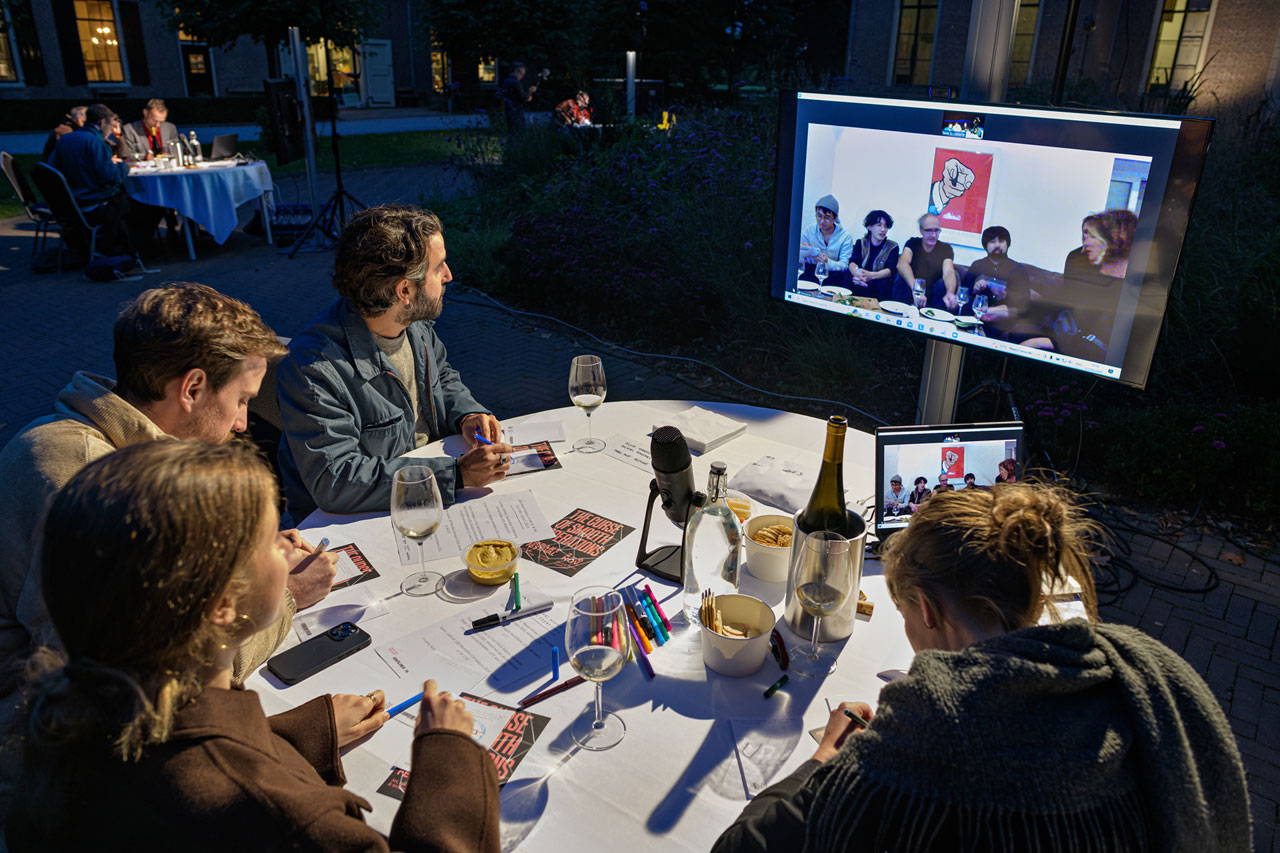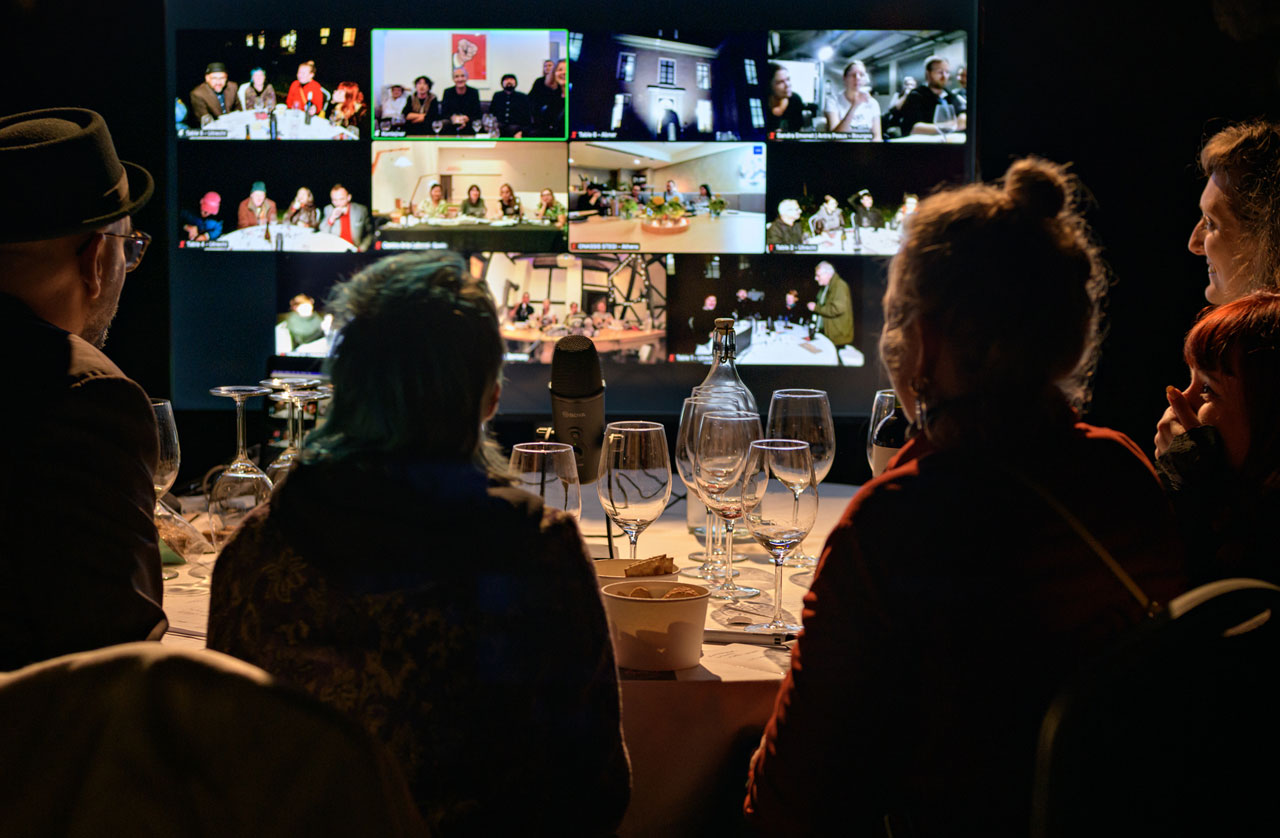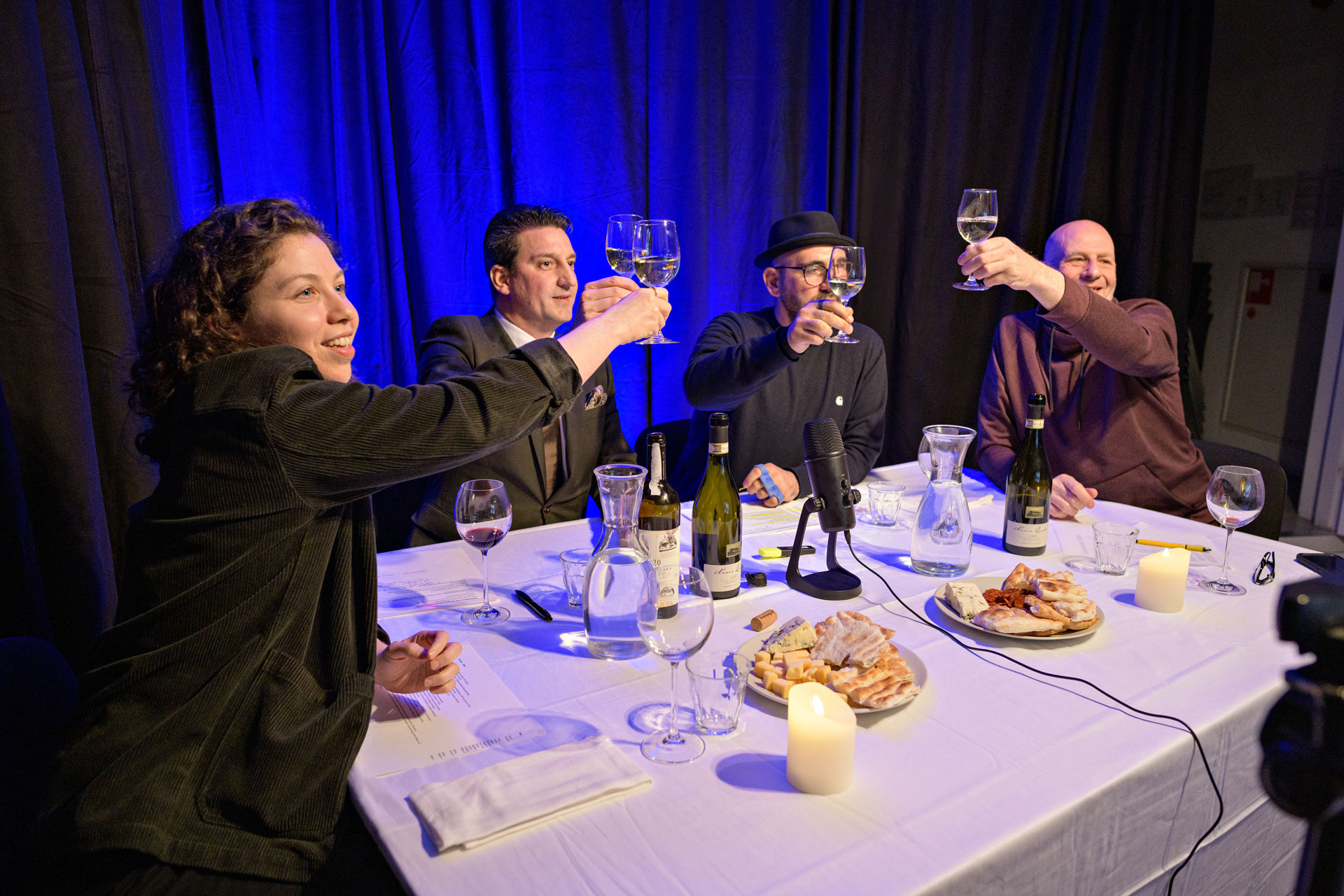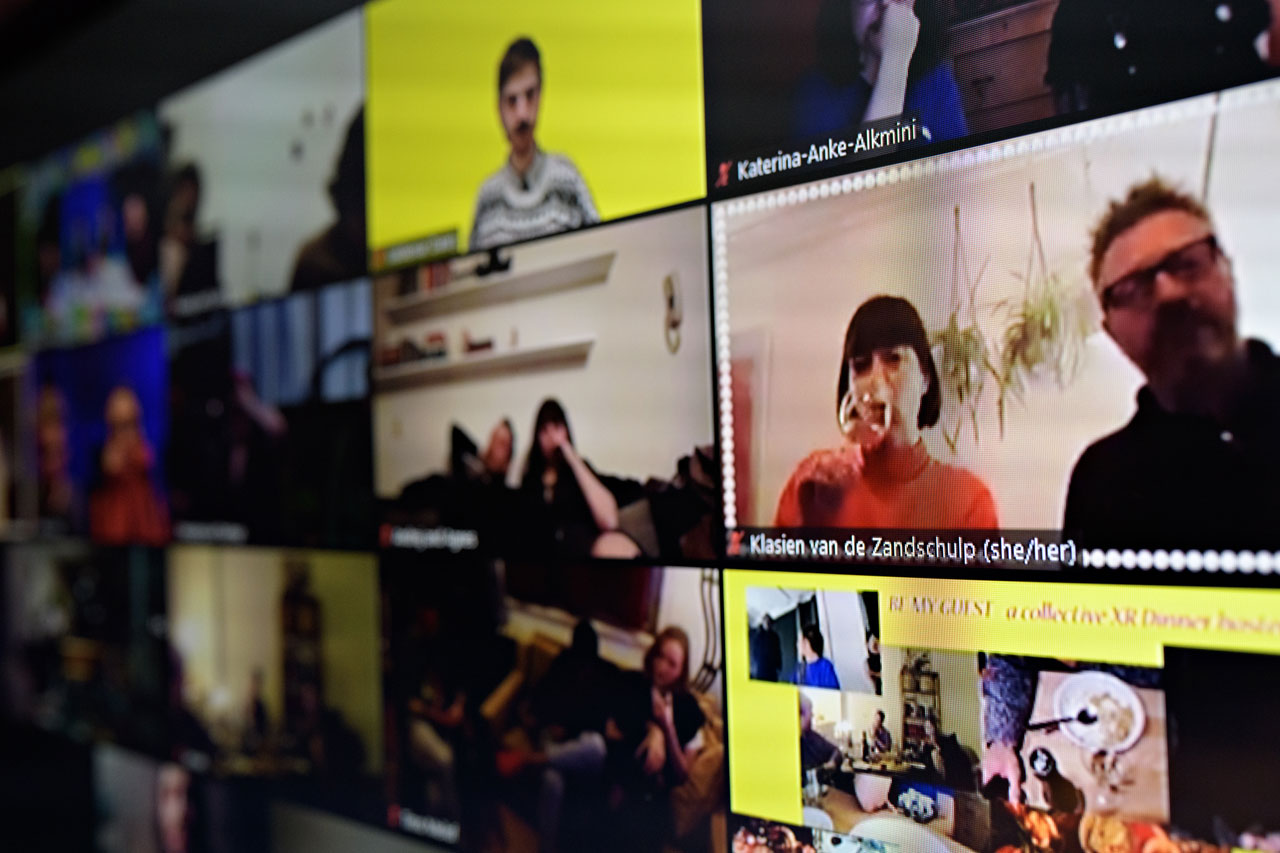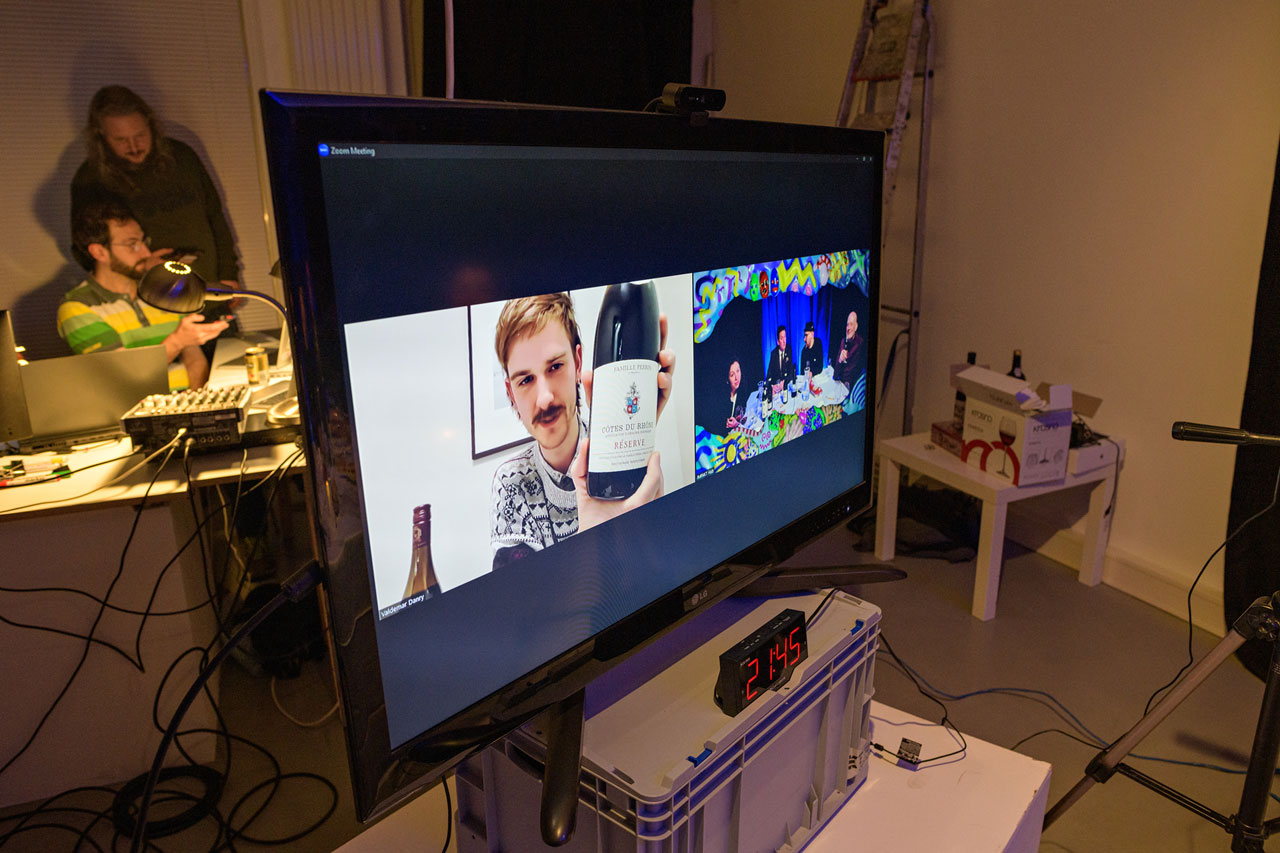Wine tasting: Difference between revisions
No edit summary |
No edit summary |
||
| (7 intermediate revisions by the same user not shown) | |||
| Line 1: | Line 1: | ||
== Wine | ==Hybrid Art and Wine Tasting== | ||
<span class="author">IMPAKT</span><br> | |||
At IMPAKT we like wine. And we like art. While people can find sharing their opinions about art daunting, the beauty of wine is that even without expertise you can taste and form an opinion. Drinking wine is a social activity that engages your senses. In the Wine Tasting events we wanted to take this as the starting point for an event that would bridge geographic, as well as cultural divides. There have now been two iterations of the International Hybrid Wine Tasting (IHWT) events– both very different from one another. However, in both editions, guests created cozy ‘table’ settings with their friends (either locally in Utrecht, or their own home) and connected at random to other remote tables via video calls. Attendees were invited to order wines pre-selected by our sommelier, so everyone was tasting the same wines. And art performances broke up rounds of wine tastings and provided fruitful topics of conversation. | |||
The two variations were quite different from one another, but follow from an iterative design process. For this reason, a brief description of, and the differences between, each iteration are detailed below. | |||
''International Hybrid Wine Tasting (1.0)'' | |||
The first edition of the International Hybrid Wine Tasting was conceptualized as a speed-dating, wine-tasting, garden party. The aim was to connect tables in Utrecht (which were open to the public through ticket sales) to tables set up throughout Europe at our partner institutions: Antre Peaux in France; Werkleitz in Germany; Onassis Stegi in Greece; Kontejner in Croatia; and Laboral in Spain. Each table had at least 5 guests sitting together, who were then able to chat freely to the guests sitting virtually across from them at a partner table. The event was hosted on Zoom and divided into five rounds, each round we would try a new wine. The wines were selected by five partner institutions. The 3 hour event is divided into five rounds, one wine to try in each round. | |||
[[File:Wine selections from first wine tasting.jpg|The five wines selected by each of our partner institutions]] | |||
= | In the garden of the historic Oud Amelisseweerd estate, located just outside of Utrecht, we set up five tables each equipped with their own video-calling set-up. Identical tables were built around Europe by our partner institutions. In total, there were ten tables that joined a collective Zoom call (5 in Utrecht, 5 over Europe). Each round began in a collective setting where all the tables were visible to each other– this provided a moment in which the wine would be introduced by the institution that chose it. Thereafter, each table in Utrecht was paired with one of the partner tables; these pairings would switch after each round. | ||
[[File:Winetasting-Event Oud Amelisseweerd set up.jpg|center|The garden layout in Oud Amelisseweerd of the five tables for the International Hybrid Wine Tasting]] | |||
<br> | [[File:Winetasting-Event Utrecht hub 2.jpg|center|An Utrecht hub connected to a partner institution during one of the tasting rounds]] | ||
< | [[File:Winetasting-Event collective moment.jpg|center|All hubs together during a collective moment in between tasting rounds]] | ||
< | During these rounds of break-out rooms, guests were invited to do two things. Firstly, they were invited to try the wine. But they were also given a game to play across the digital divide with the table they were paired with. These games were themed around one of the five senses. | ||
''Lessons Learned'' | |||
Following the success of the first wine tasting, there were some identifiable goals we had for the second iteration. Firstly, we aimed to make it more accessible to the public: although the first version was open to the public, those tickets were limited. Secondly, we aimed to create a version of the event that we could replicate in the future. The Oud Amelisseweerd location was beautiful, but it was also a large productional undertaking to transform into a hybrid hub of operations. The aim for the second tasting was to design an event that could match in ambience but requiring less time/resources to produce. And lastly, the new events needed to have more opportunities to showcase (hybrid) media art in this unique event environment. | |||
''Hybrid Wine and Art Tasting Event (2.0)'' | |||
Version two, renamed the Hybrid Wine and Art Tasting, asked guests to invite their friends over to their houses, and turn their own living rooms into hubs. Each of these physical hubs would in turn become one of the webcams to be connected to other living rooms in the roulette rounds. As in the last iteration, wines were selected by our sommelier to be tasted in each round. However, this time, the selection was limited to three rounds. The selected wines were available for guests to order, so that everyone attending could share their experience of tasting the same wines. The first round was a white wine; the second, a red wine; and for the final round guests were asked to pick their own wine, which they could then describe to their virtual interlocutors. | |||
[[File:Hybrid-Wine-and-Art-Tasting-Event Utrecht Hub.jpg|center|The Utrecht hub (a.k.a. the MC table) cheers-ing on location in the IMPAKT studio]] | |||
[[File:Hybrid-Wine-and-Art-Tasting-Event collective moment.jpg|center|Collective moment]] | |||
[[File:Hybrid-Wine-and-Art-Tasting-Event 2 hubs connected.jpg|center|Two hubs connected during the final tasting round, sharing the wine they selected for the final round]] | |||
We still set up a central hub in Utrecht, at the IMPAKT office, that acted as both the technical operational center for the event, as well as the podium for the evening’s Master of Ceremony. The MC table in Utrecht seated Abner Preis (the evening’s MC), Arjon Dunnewind (Director of IMPAKT), Daniela Tenenbaum (Assistant Curator at IMPAKT), and Guillaume Coret (Utrecht-based wine sommelier from Fijn-Proeverij.nl). | |||
In each round, the hubs were put into breakout rooms in pairs, or groups of three. Guests were instructed to limit their living room groups to 6 people behind the webcam, to ensure everyone was well audible. The event was once again hosted on Zoom, which has an upper limitation of 50 breakout rooms (=900 people maximum capacity). Having this decentralized, DIY, invitation to the event meant that the number of participants was practically unlimited. | |||
The removal of two wine tasting rounds allowed for more time to be dedicated to the two themed performances of the evening. Both were performances around the shared experience of dining in augmented/virtual reality settings, and thus, very topical for the evening. | |||
The first was [https://impakt.nl/events/2023/event/impakt-hybrid-wine-and-art-tasting-event/metaphysical-tastings/ Metaphysical Tastings], a multidisciplinary experience by artists Sophia Bulgakova, Leo Scarin & Cemre Deniz Kara that combines dining rituals and virtual reality. In Metaphysical Tastings, you are guided through a tasting experience together with other guests in different physical locations, while entering a series of digital environments designed to match the food served – its colour, texture, sound, and other properties – to create a synesthetic journey. The project explores the sensorial correlations that originate in the combination of participatory, immersive media and food design and the experiential implications of social gatherings in virtual and physical realities. | |||
The second performance was [https://impakt.nl/events/2023/event/impakt-hybrid-wine-and-art-tasting-event/be-my-guest/ BE MY GUEST!] by Cenk Güzelis, Valdemar Danry and Anna Pompermaier. You are invited to a mixed reality dinner. An AI will be your host for this special evening, entertaining you and your fellow guests, experimenting with recipes and guiding you into its dinner concept. Welcome to Be My Guest!, an experimental social gathering by artists and designers Cenk Güzelis, Valdemar Danry and Anna Pompermaier. The project combines architecture, new media, and Artificial Intelligence to investigate the future of our hybrid realities, in which the physical and digital realms are continuously intertwined. | |||
<br />Make it Participatory | |||
Each hub is responsible for their own set up, but gets to participate in both the tasting, and the novelty of the roulette/speeddate rounds. | |||
<br />Cultivate Collectivity | |||
Sharing the experience of drinking wine together creates a built-in sensory activity that helps synchronize the collectivity. | |||
<br />Create Comfort | |||
The sensory focus means everyone can form an opinion about wine, and provides a common factor that can connect people across virtual divides. | |||
Furthermore, the design tried to mimic the familiarity of sitting together tat a round table. The instructions for setting up the hubs were such that when guests were put into breakout rooms the Zoom interface was minimized as much as possible. This was important to mold the hybrid environment to make it look as if the connected hubs were sitting across the table from one another. (pic ref). | |||
<br />Fair Tech Choices | |||
Although we strive to use alternative platforms for our events, sometimes this comes at the cost of stability/reliability. In addition to this, we also needed a platform that was somewhat familiar to, and usable by, all members of our target audience (of various technical literacy, age, locations, etc). In the case of the Wine Tasting when the aim was to have a smooth connection that promoted seamless communication, we opted for Zoom as a reliable facilitator that was familiar to all envisioned guests. | |||
Latest revision as of 11:45, 25 July 2023
Hybrid Art and Wine Tasting
At IMPAKT we like wine. And we like art. While people can find sharing their opinions about art daunting, the beauty of wine is that even without expertise you can taste and form an opinion. Drinking wine is a social activity that engages your senses. In the Wine Tasting events we wanted to take this as the starting point for an event that would bridge geographic, as well as cultural divides. There have now been two iterations of the International Hybrid Wine Tasting (IHWT) events– both very different from one another. However, in both editions, guests created cozy ‘table’ settings with their friends (either locally in Utrecht, or their own home) and connected at random to other remote tables via video calls. Attendees were invited to order wines pre-selected by our sommelier, so everyone was tasting the same wines. And art performances broke up rounds of wine tastings and provided fruitful topics of conversation.
The two variations were quite different from one another, but follow from an iterative design process. For this reason, a brief description of, and the differences between, each iteration are detailed below.
International Hybrid Wine Tasting (1.0)
The first edition of the International Hybrid Wine Tasting was conceptualized as a speed-dating, wine-tasting, garden party. The aim was to connect tables in Utrecht (which were open to the public through ticket sales) to tables set up throughout Europe at our partner institutions: Antre Peaux in France; Werkleitz in Germany; Onassis Stegi in Greece; Kontejner in Croatia; and Laboral in Spain. Each table had at least 5 guests sitting together, who were then able to chat freely to the guests sitting virtually across from them at a partner table. The event was hosted on Zoom and divided into five rounds, each round we would try a new wine. The wines were selected by five partner institutions. The 3 hour event is divided into five rounds, one wine to try in each round.
In the garden of the historic Oud Amelisseweerd estate, located just outside of Utrecht, we set up five tables each equipped with their own video-calling set-up. Identical tables were built around Europe by our partner institutions. In total, there were ten tables that joined a collective Zoom call (5 in Utrecht, 5 over Europe). Each round began in a collective setting where all the tables were visible to each other– this provided a moment in which the wine would be introduced by the institution that chose it. Thereafter, each table in Utrecht was paired with one of the partner tables; these pairings would switch after each round.
During these rounds of break-out rooms, guests were invited to do two things. Firstly, they were invited to try the wine. But they were also given a game to play across the digital divide with the table they were paired with. These games were themed around one of the five senses.
Lessons Learned
Following the success of the first wine tasting, there were some identifiable goals we had for the second iteration. Firstly, we aimed to make it more accessible to the public: although the first version was open to the public, those tickets were limited. Secondly, we aimed to create a version of the event that we could replicate in the future. The Oud Amelisseweerd location was beautiful, but it was also a large productional undertaking to transform into a hybrid hub of operations. The aim for the second tasting was to design an event that could match in ambience but requiring less time/resources to produce. And lastly, the new events needed to have more opportunities to showcase (hybrid) media art in this unique event environment.
Hybrid Wine and Art Tasting Event (2.0)
Version two, renamed the Hybrid Wine and Art Tasting, asked guests to invite their friends over to their houses, and turn their own living rooms into hubs. Each of these physical hubs would in turn become one of the webcams to be connected to other living rooms in the roulette rounds. As in the last iteration, wines were selected by our sommelier to be tasted in each round. However, this time, the selection was limited to three rounds. The selected wines were available for guests to order, so that everyone attending could share their experience of tasting the same wines. The first round was a white wine; the second, a red wine; and for the final round guests were asked to pick their own wine, which they could then describe to their virtual interlocutors.
We still set up a central hub in Utrecht, at the IMPAKT office, that acted as both the technical operational center for the event, as well as the podium for the evening’s Master of Ceremony. The MC table in Utrecht seated Abner Preis (the evening’s MC), Arjon Dunnewind (Director of IMPAKT), Daniela Tenenbaum (Assistant Curator at IMPAKT), and Guillaume Coret (Utrecht-based wine sommelier from Fijn-Proeverij.nl).
In each round, the hubs were put into breakout rooms in pairs, or groups of three. Guests were instructed to limit their living room groups to 6 people behind the webcam, to ensure everyone was well audible. The event was once again hosted on Zoom, which has an upper limitation of 50 breakout rooms (=900 people maximum capacity). Having this decentralized, DIY, invitation to the event meant that the number of participants was practically unlimited.
The removal of two wine tasting rounds allowed for more time to be dedicated to the two themed performances of the evening. Both were performances around the shared experience of dining in augmented/virtual reality settings, and thus, very topical for the evening.
The first was Metaphysical Tastings, a multidisciplinary experience by artists Sophia Bulgakova, Leo Scarin & Cemre Deniz Kara that combines dining rituals and virtual reality. In Metaphysical Tastings, you are guided through a tasting experience together with other guests in different physical locations, while entering a series of digital environments designed to match the food served – its colour, texture, sound, and other properties – to create a synesthetic journey. The project explores the sensorial correlations that originate in the combination of participatory, immersive media and food design and the experiential implications of social gatherings in virtual and physical realities.
The second performance was BE MY GUEST! by Cenk Güzelis, Valdemar Danry and Anna Pompermaier. You are invited to a mixed reality dinner. An AI will be your host for this special evening, entertaining you and your fellow guests, experimenting with recipes and guiding you into its dinner concept. Welcome to Be My Guest!, an experimental social gathering by artists and designers Cenk Güzelis, Valdemar Danry and Anna Pompermaier. The project combines architecture, new media, and Artificial Intelligence to investigate the future of our hybrid realities, in which the physical and digital realms are continuously intertwined.
Make it Participatory
Each hub is responsible for their own set up, but gets to participate in both the tasting, and the novelty of the roulette/speeddate rounds.
Cultivate Collectivity
Sharing the experience of drinking wine together creates a built-in sensory activity that helps synchronize the collectivity.
Create Comfort
The sensory focus means everyone can form an opinion about wine, and provides a common factor that can connect people across virtual divides.
Furthermore, the design tried to mimic the familiarity of sitting together tat a round table. The instructions for setting up the hubs were such that when guests were put into breakout rooms the Zoom interface was minimized as much as possible. This was important to mold the hybrid environment to make it look as if the connected hubs were sitting across the table from one another. (pic ref).
Fair Tech Choices
Although we strive to use alternative platforms for our events, sometimes this comes at the cost of stability/reliability. In addition to this, we also needed a platform that was somewhat familiar to, and usable by, all members of our target audience (of various technical literacy, age, locations, etc). In the case of the Wine Tasting when the aim was to have a smooth connection that promoted seamless communication, we opted for Zoom as a reliable facilitator that was familiar to all envisioned guests.
